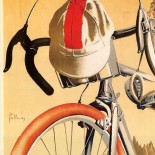Cycling Patents of Yesteryear: No. 8 – Ulysses F. Henderson’s Bicycle-Handle, 1897
Handlebars, like saddles and pedals, are important components of the bicycle because they are the contact points between the rider and the machine. Poor adjustment or a design that doesn’t fit the anatomical proportions of the rider can swiftly lead to discomfort and even injury. Handlebars also play an important part in a rider’s position on the bicycle and have a significant effect on their aerodynamic profile.
The first handlebars, seen on the Draisine and other velocipedes, were made of wood. A material that was still being used at the cheaper end of the bicycle market in America as late as the 1890’s. By the latter half of the nineteenth century, iron or steel was, however, by far the most common material in use, with handlebars made from round-section rod or tubular steel. Early handlebars were of the straight variety, with designs that included varying degrees of curvature that swept the hand grips back towards the rider.
Cyclists soon learned that adopting a stooped position reduced air resistance and allowed them to go faster, which in turn led to designs that had an element of drop in them. For example, the adjustable handlebar patented by Morgan H. Vanevera in 1896 allowed the rider to adjust the handlebars along the vertical plane allowing for a more or less upright position as desired.
Vanevera’s patent certainly provided a solution but was arguably impractical. Vanevera envisaged the rider releasing a locking pawl with one hand while rocking the handlebar into the desired position with the other. All whilst in motion. More sensible designs left the handlebar fixed, instead making use of bends in the tubing to provide for multiple hand positions.Three years before Vanevera received his patent, one Ulysses F. Henderson of New Lebanon in the county of Mercer, Pennsylvania, submitted his own patent application for a handlebar, of which in his own words:
The leading feature of the design resides in a handle-bar formed at each side of a central point between its ends with a complete circular convolution or coil whose center lies in a plane approximately parallel with a plane disposed longitudinally of the bar, thereby giving the convolution or coil a vertical disposition, the twist of the bar forming the convolution or coil thereof following a spiral line’ and thereby deflecting the terminals of the bar in an outward direction [2].
By which convoluted language he meant that the handlebar looked like this:
While not adjustable on the move, the “complete circular convolution” meant that the handlebar could be installed to either allow the rider to adopt an upright position or a dropped position, depending on which way round the handlebar was fitted. A solution that was both “useful and ornamental” [3].
______
[1] Morgan H. Vanevera, Adjustable handle-bar for bicycles, US Patent 620,684, filed February 24, 1896, and issued March 7, 1899.
[2] Ulysses F. Henderson, Design for a bicycle-handle, US Patent 26,542, filed December 16, 1896, and January 19, 1987.
[3] Ibid.
Information
This entry was posted on February 25, 2016 by Aaron in Cycling, Cycling Tech, Patents, United States and tagged Cycling, Cycling History, Cycling Patent, Handlebars, History, Morgan H. Vanevera, Nineteenth Century, Ulysses F. Henderson, US Patent 26524.Shortlink
https://wp.me/p5eGAy-EIRecent Posts
- “Any Woman Can Make a Skirt” – Fashion Tips for Women Cyclists
- Russia invented the bicycle (?)
- Cycling Patents of Yesteryear: No. 9 – Rastetter and Siebold’s Child Seat Attachment for Bicyles, 1891
- The LAW Comes To Green Bay
- Military Cycling: The British Army Chooses a Bicycle
- Forty Years of Australian Club Racing: The Dandenong Cycle Club, 1908-1948
- Cycling Patents of Yesteryear: No. 8 – Ulysses F. Henderson’s Bicycle-Handle, 1897
- Mrs F. M. Cossitt: The First Woman to Ride a Bicycle in New York?
- The Hidden Dangers of Cycling: Is it Healthy? (Clue: yes it is)
- Cycling Shorts: Descending the Eiffel Tower
- Cycling Board Games
- Merry Christmas
- Cycling Shorts: Richter’s Raketenrad
- Transferable Technology: From the Bicycle to the Aeroplane and the Car
- Cycling Shorts: The Peace Race, 1974
- A History of Cycling in n+1 Objects: No 5 – The American Star Bicycle, 1881-1893(?)
- Military Cycling: The Volunteer Easter Manoeuvres, 1888
- Bacchus on a Bicycle: Cycling Under The Influence
- Cycling Patents of Yesteryear: No. 7 – Evan S. Connell Jr’s Bicycle Attached Toy Machine Gun, 1951
- Guns, Wheels, and Steel: Cyclists and Small Arms in the Late 19th Century
Categories
- Advertising
- Art
- Australia
- Bicycle Companies
- Children and Cycling
- Classics
- Crashes
- Cycling
- Cycling Clubs
- Cycling Shorts
- Cycling Tech
- Dauphiné Libéré
- Endurance Racing
- France
- Germany
- Great Rides
- History
- History of Cycling in n+1 Objects
- Italy
- Le Tour de France
- Malawi
- Military Cycling
- One Day Races
- Patents
- Peace Race
- People
- Racing
- Riders
- Road Racing
- Russia
- Spain
- Stationary Bike Racing
- Track Racing
- Training Aids
- United Kingdom
- United States
- Vuelta d'Espana
- Women and Cycling
Archives
Blogs I Follow
- The Dandenong Ranges
- Domestic Fits
- Defence-In-Depth
- Maxine Dodd Art
- Cycle Write Blog
- Cycling in a skirt
- I Do Not Despair
- PedalWORKS
- Storyshucker
- heritagelandscapecreativity
- thornews.wordpress.com/
- lemanshots - Fine Pictures and Digital Art
- The Victorian Cyclist
- Cycling History
- historywithatwist
- Rhyl History Club
- Europeenses
- Rearview Mirror
- Cooking Without Limits


